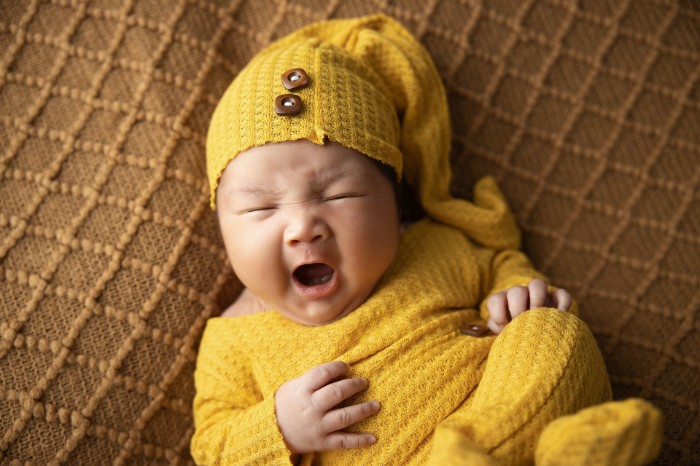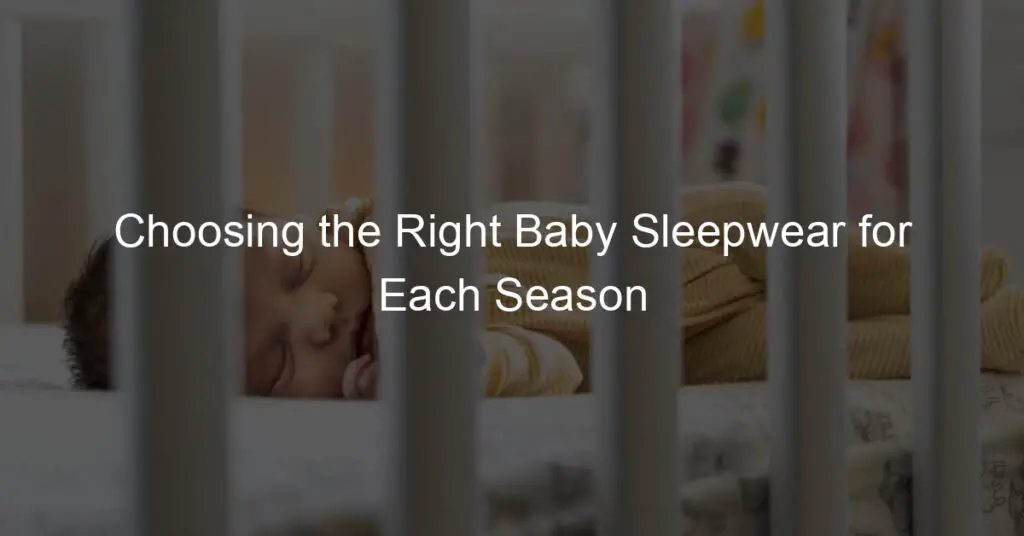As a first-time parent, the question of what your baby should wear under the sleep sack can be a bit daunting. After all, you want to ensure that your little one is comfortably and warmly dressed. But what should a baby wear under a sleep sack? Let’s find out!
In this blog post, we’ll explore the different clothing options available for babies under their sleep sacks.
Why Do Babies Need Sleep Sack?

Sleep sacks are babies wear, designed to keep your baby warm while they sleep comfortably. Typically made from a soft, breathable material like cotton or flannel, sleep sacks also provide some protection against Sudden Infant Death Syndrome (SIDS). Sleep sacks can be used in both cribs and bassinets.
When it comes to what a baby should wear underneath their sleep sack, the most important thing is comfort. It’s best to choose lightweight fabrics that will keep your baby cozy without making them too hot.
Cotton onesies with no feet make great base layers for babies to sleep in cooler climates. If you’re looking for something warmer, opt for footed pajamas or fleece jumpsuits instead. Sleep bags and Bassinets are also great options for keeping your baby’s sleep time warm.
Read More: 4 Month Sleep Regression Or Teething
What Should A Baby Wear Under A Sleep Sack?
Sleep sacks are great because they’re designed to keep your baby warm dress your baby for sleep properly, to secure without having the worry of them becoming tangled or too hot. But what should you put under your baby’s sleep sack for extra warmth and comfort? Let’s take a look.
Layering Up
When it comes to dressing babies for bedtime, layering up is key. The layering process starts with a onesie (also known as an undershirt). A onesie is a perfect foundation for pajamas because it’s not too thick or too thin and provides just enough coverage.
You can choose from long sleeves or short sleeves depending on the temperature in your home. Some babies are comfortable in short sleeve onesies and footed pajamas or a cotton sleep sack, while others may need some additional warmth.
Adding A Sleep Gown
The next layer to consider is a sleep gown. Sleep gowns are great for newborns who tend to kick off their blankets during the night—the snug fit of the sleep gown prevents them from getting uncovered during sleep time.
Plus, they make diaper changes easier since you don’t have to completely undress your baby every time they need to be changed! It’s also important to note that some babies may find long sleeves uncomfortable at night, so choosing a sleeveless option can help prevent them from getting overheated.
Read More: What Time Should My Baby Wake Up In The Morning?
Putting On The Sleep Sack
Once you’ve layered up correctly with both undershirts and sleep gowns (if necessary), it’s time to put on the sleep sack itself! Sleep sacks come in various sizes and materials, such as merino wool or muslin cotton blends.
Be sure to select a size that fits snugly but still allows freedom of movement—too loose could lead to your baby getting tangled up in it during their slumber! Finally, add an extra blanket over the top if needed; this will provide additional warmth without risking suffocation or overheating due to layers of fabric around their neck and face area.
For Colder Months
If the temperature drops during colder months, you may need an extra layer of protection for your baby while they sleep. In this case, consider adding a lightweight long-sleeve shirt or fleece sleeper underneath their sleep sack. Be sure not to go overboard with heavy materials such as wool or down as these can cause overheating and also make it difficult for your baby to move around in their sleep sack.
In Warmer Months
During warm weather months when baby’s room temperatures rise, you may want to consider dressing your baby in light layers such as a cotton undershirt and lightweight pants or shorts instead of a onesie or footed pajamas. This will help keep them cool while they’re sleeping without having too much bulk that could make them uncomfortable in their sleep sack.
Read More: How To Stop Baby Waking At Night Out Of Habit
Benefits Of Dressing Your Baby Underneath Their Sleep Sack

The main reason for dressing your baby in a onesie or pajamas underneath their sleep sack is to help regulate their body temperature. Babies cannot regulate their own body temperature yet, so you want to make sure that they are wearing enough layers to stay warm without becoming too hot or uncomfortable. You may also need one or two more layers if the room is cold.
For example, if the air conditioner is running during warmer months or there are drafts in winter months, then you might need extra layers on top of the onesie or pajamas to keep them warm.
The best fabric for this type of clothing should be lightweight and breathable—such as cotton—so that your little one does not become too hot during the night. Also, make sure whatever clothes you choose are soft and non-irritating against their skin; babies have very sensitive skin so avoid materials such as wool or polyester.
Using a Blanket instead of Clothing Underneath a Sleep Sack Is Not Recommended. It’s important to remember that using a blanket instead of clothing underneath a sleep sack can be dangerous for your little one because blankets can come loose during the night and cover your baby’s face.
This is why it’s recommended by pediatricians that babies do not use loose blankets in their crib until they reach 12 months old; this will reduce the risk of SIDS (Sudden Infant Death Syndrome).
Instead, opt for something like a wearable blanket (a type of sleeping bag with armholes) once your baby reaches 6 months old as these have been proven safer than traditional blankets and can also help regulate their body temperature better than loose blankets.
Read More: How To Keep A Baby Warm At Night
Understanding Your Baby’s Comfort: Signs of Overheating and Cold
Recognizing the signs of your baby’s discomfort due to temperature is crucial. Babies can’t verbally express how they’re feeling, but their bodies give us clues. If your baby’s face is flushed, they’re sweating, or their chest feels hot, they may be too warm.
Conversely, if your baby’s hands and feet are cold to the touch, they might need an additional layer of clothing. Remember that babies usually have colder extremities, so it’s essential to check their torso or back for a more accurate sense of their body temperature.
Balancing your baby’s comfort level requires careful monitoring and adjustments based on your baby’s signals.
Choosing the Right Sleep Sack: Factors to Consider
Picking the perfect sleep sack for your baby involves several considerations. First, think about the material. Breathable fabrics like cotton or muslin are ideal. Next, consider the room temperature and time of year.
Thicker materials might be needed for colder months, while lighter ones are better for warmer seasons. Size is another significant factor. Ensure the sleep sack isn’t too big that it could potentially cover the baby’s face or too tight that it restricts movement.
Finally, ease of use is key, particularly for those middle-of-the-night diaper changes. Sleep sacks with zippers are generally easier to manage than those with snaps.
Safe Sleep Practices: Reducing the Risk of SIDS
The American Academy of Pediatrics (AAP) has several recommendations for safe sleep to reduce the risk of SIDS. Always place your baby on their back to sleep, in a crib or bassinet with a firm mattress and fitted sheet.
Keep the sleep area free from pillows, blankets, toys, and other items until the child is at least one year old. Using a sleep sack can replace the need for loose blankets, further reducing the risk. Maintain a comfortable temperature in the baby’s room, and avoid overheating by dressing the baby lightly for sleep.
Transitioning to Sleep Sacks: When and How
Moving your baby to a sleep sack can be done once they’ve outgrown the swaddle, typically around two to three months old. Start the transition by swaddling your baby with one arm out, then both arms out.
Eventually, you can completely replace the swaddle with the sleep sack. Introduce the sleep sack during naps before using it at night, and always ensure the sleep sack fits properly and doesn’t obstruct the baby’s face.
Understanding the Role of Sleep Sacks in a Baby’s Sleep Routine
Sleep sacks can play a key role in establishing a solid sleep routine for your baby. Not only do they signal it’s time to sleep, but they also provide a safe, cozy environment akin to the womb. The consistent use of a sleep sack can help your baby understand that it’s bedtime, aiding in better sleep habits.
Furthermore, sleep sacks can be used when traveling to give your baby a familiar sleep setting, no matter where you are.
Frequently Asked Questions about Baby Sleep Sacks
This section can be dedicated to addressing common queries about sleep sacks, such as their safety profile, when to start using them, and how to choose the right size. You can also cover questions on washing instructions and when to move from a swaddle to a sleep sack.
Having a FAQ section is beneficial for readers as it provides concise answers to their potential queries, making it a useful resource for new parents.
How to Wash and Care for Your Baby’s Sleep Sack
Proper care of your baby’s sleep sack extends its longevity and ensures it remains safe for your baby. Always follow the manufacturer’s care instructions on the label. Generally, most sleep sacks can be machine washed in cold water and tumble-dried on low heat.
However, avoid using bleach or fabric softeners as they can deteriorate the fabric over time and may irritate your baby’s skin. If the sleep sack is stained, treat the spot with a gentle stain remover suitable for baby clothes.
Always ensure the sleep sack is completely dry before using it to avoid any mildew or mold buildup.
The Dos and Don’ts of Baby Sleepwear
When it comes to baby sleepwear, there are certain things you should and shouldn’t do for your baby’s safety and comfort. Do choose breathable materials such as cotton or muslin to prevent overheating.
Do ensure the clothing fits well and does not have loose elements that could pose a choking hazard. Don’t overdress your baby; it’s better to adjust the room temperature or use a sleep sack for extra warmth. Don’t use loose blankets in the crib; opt for a sleep sack instead.
Finally, don’t ignore signs of discomfort or overheating from your baby, always adjust their clothing according to their needs and the room temperature.
Additional Sleep Accessories to Consider for Your Baby
Apart from sleep sacks, there are other sleep accessories that you might consider for your baby’s comfort and safety. A crib wedge, for instance, can help babies with reflux sleep more comfortably.
Sound machines with white noise can soothe a baby to sleep and drown out household noise. A room thermometer can help you maintain the ideal room temperature for your baby.
However, remember that any additional accessories should be used with safety in mind, avoiding items that could pose a suffocation or entanglement risk.
The Importance of Choosing Hypoallergenic Materials for Baby Sleepwear
Babies have sensitive skin, so it’s important to select hypoallergenic materials for their sleepwear and sleep sacks. Hypoallergenic fabrics are made without harsh chemicals or dyes and are less likely to cause allergic reactions or skin irritation.
Organic cotton is a great hypoallergenic choice as it’s not only soft and breathable but also grown without harmful pesticides or chemicals. Choosing hypoallergenic sleepwear can provide peace of mind and extra comfort for your baby.
Sleep Sack Safety: What to Look For
When selecting a sleep sack, safety should always be your primary concern. Firstly, ensure that the sleep sack is the correct size for your baby. It should not be too big that it could potentially cover your baby’s face, nor too tight that it restricts their movement.
Check that the sleep sack doesn’t have any loose threads or decorations that could pose a choking hazard. If it has a zipper, ensure that it’s covered at the top to prevent your baby’s skin from being zipped up accidentally.
It’s also important to choose a sleep sack that is sleeveless, as sleeves can make the baby too warm and lead to overheating. Lastly, always go for sleep sacks that meet safety standards, and opt for those that are free from harmful substances like flame retardants or harsh dyes.
How to Introduce Your Baby to the Sleep Sack: Tips and Tricks
The transition to a sleep sack might take some time for your baby, but a few tips can make the process smoother. Start introducing the sleep sack during naps before moving on to nighttime sleep.
This allows your baby to get accustomed to the feel of the sleep sack without disrupting their nighttime sleep routine. You can also place the sleep sack near you or in your bed for a few nights before introducing it to your baby.
Your scent can provide comfort and help your baby associate the sleep sack with sleep and safety. Be patient during this transition period, as your baby may need a few days or even weeks to adjust.
Sleep Sack Alternatives: What Else Can Be Used?
While sleep sacks are a great choice for keeping your baby warm and safe during sleep, there are also a few alternatives available. One is the wearable blanket, which is similar to a sleep sack but features openings for the baby’s arms.
This design can provide some extra freedom of movement for older babies. Another alternative is footed pajamas, which can be used alone or underneath a sleep sack for added warmth. There are also sleeping bags specifically designed for babies, which are typically sleeveless and feature a zippered opening.
Lastly, swaddling is a time-tested method for newborns, providing a snug, womb-like environment. However, once your baby starts showing signs of rolling over, it’s time to transition to a safer sleep option like a sleep sack or wearable blanket.
Conclusion
Dressing your baby in a onesie or pajamas underneath their sleep sack is an important part of helping them regulate their body temperature at night. Be sure to select lightweight, breathable materials such as cotton which won’t irritate their skin, and opt for fitted clothing instead of a blanket that can come loose during the night.
Doing this will ensure your little one is comfortable without overheating, no matter what the season.
Read More: How To Keep Your Baby Safe While Sleeping














